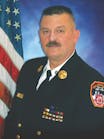When fire department personnel respond to a commercial kitchen range hood fire with fire possibly extending into the exhaust duct above in a high-rise building, the two primary considerations that must be determined while the fire is being brought under control are:
- Where does the duct terminate?
- Where does it penetrate the floor above if it does not discharge directly outside the building?
What is typically lacking in these fires is quick access to accurate information regarding these two concerns. Even if the chief engineer is available and not off duty, or just off premises, chances are good he will not know one or both of these answers. Drawings must be retrieved from the blueprint room and read. Unfortunately, this usually proves impractical due to not being able to find these drawings or read the blueprints (which are very difficult to read/understand). Inevitably, fire crews must search for the ductwork, which usually results in increased damage to the building. Thermal imaging cameras and a user-friendly drawing of the building ductwork can be tremendously effective tools in quickly and effectively gaining full control over the incident.
Case Study 1
The New York City Fire Department responded to a working restaurant fire where the restaurant was well-involved on arrival and fire was extending throughout the exhaust duct from built-up grease due to lack of proper and effective cleaning of the duct. The restaurant was attached to the side of a 45-story office building, extending out approximately 40 feet toward the side street. While the fire was being fought by multiple alarm companies, the incident commander accessed the building's pre-fire plan, which the owner had done voluntarily.
The ventilation diagram showed that the kitchen duct did not pass up above the restaurant and out the roof of the one-story building. It actually went up into the ceiling void space, turned 90 degrees and passed all the way through the 45-story office building into another one-story restaurant on the opposite side of the block, then turned 90 degrees again and penetrated the roof, where it terminated with an exhaust hood enclosure. Fire had raced the entire length of the duct and ignited this enclosure on the roof of the second building a block over from the initial fire building.
The incident commander noted where the duct traveled and terminated just as fire began to show from the other restaurant's roof. Crews quickly chased down and effectively extinguished all fire in the shaftway and roof enclosure while the main fire was continuing to be fought. The fire was brought under control within the hour, but the initial fire building was nearly destroyed and shortly thereafter razed. The fire never extended into the high-rise building itself, aside from the shaftway running horizontally through the first-floor ceiling void.
Case Study 2
The Chicago Fire Department responded to a report of heavy smoke showing from the roof of a 40-story twin-tower office complex which also happened to house the Chicago Mercantile Exchange. The complex was fully occupied at the time. Just as fire crews began arriving, both towers began to evacuate all floors due to the building security and engineering staff panicking a bit because of the heavy volume of smoke pushing out the roof of one of the towers.
I was in Chicago that day, meeting with the building owner representative several blocks away when an excited secretary charged into the room announcing the fire. We decided to walk down and check it out, as two alarms of equipment began arriving on scene. The crews were met with thousands of tenants streaming out of the lobby, onto the sidewalks and even the street fronting the building. The first-due chief was not happy about the buildings being dumped without his approval.
The fire started in a restaurant directly beneath the trading floor for "the Merc," with fire extending into the exhaust duct. These occupancies were situated between the two towers comprising the complex. The smoke everyone saw was the grease burning in the kitchen exhaust duct and discharging out the roof of the south tower. The chiefs at the command post knew me and I volunteered to find the engineer and chase down the heating, ventilating and air conditioning (HVAC) system drawings to determine exactly where the duct penetrated (horizontally and vertically) the south tower to assist fire crews assigned to checking extension.
The fire was quickly controlled in the restaurant, but the still-heavy volume of smoke coming out the roof meant we still had fire in the ductwork. After gaining access to the necessary print and seeing where the duct traveled in the void spaces, I went with a crew up to the second floor of the south tower and entered a storage room, pointing to where the general area was that the duct should be. The crew brought all the appropriate equipment to do the job, including a thermal imaging camera. They were very experienced firefighters and had a good working knowledge of how to properly use the camera. As ceiling tiles were being carefully removed, they immediately found the duct and determined there was fire in the duct at that location. They set up a stepladder, opened up the duct and easily extinguished the fire with a portable extinguisher. It did not appear that the fire was extending vertically into the office tower's upper floors. With the use of the camera, much damage was avoided and the entire fire was brought under control within 30 minutes. It showed me how effective a tool these cameras can be on these types of fires.
Conclusions
The challenging aspect of fighting these fires is trying to figure out where the duct terminates and where it penetrates various spaces. Some exhausts may discharge directly outside the building at that floor, some may travel up a few floors and discharge outside the tower at a level well above the kitchen, while others travel the entire length of the building up and out the roof (see graphics). Depending how much grease is built up in these ducts and how much of it is burning, these fires can be either rapidly handled very early into the fire or they can turn into multiple-alarm, raging fires if the fire shows in multiple points and/or extends out of the duct through a crack or open crease in the duct, allowing fire to leave the shaft and enter the building it is housed in. It must be noted that with this occurring, even in a "fully sprinklered building" (very loose statement), it will be breaking out in void spaces where there likely will be no fire suppression systems present. Fire crews must locate and fight these fires manually. If these ducts pass through a ceiling void that is also used as an open plenum return, this may present an additional problem if the fire is pulled back toward the core by the HVAC system, while feeding on plenum wiring.
Not all buildings have return duct detectors that will shut down fans should smoke be present in these shafts, plus there is not always a guarantee the system will indeed shut down anyway, as systems do fail through lack of maintenance or testing, even improper installation of key components. A well-constructed duct is well-suited to containing fire, but where the sections connect can be avenues for fire travel outside the duct if they are not properly sealed. Many times, building owners hire a professional cleaning firm to clean the ducts and clear the grease built up over time. However, too often, a poor job is done, resulting in a continual buildup until one day the temperature is reached where the grease ignites and fire erupts. This is especially true when the duct is difficult to clean due to numerous turns and elbows. Maintenance is vital to preventing fires in these shafts.
CURTIS S.D. MASSEY is president of Massey Enterprises Inc., the world's leading disaster-planning firm. Massey Disaster/Pre-Fire Plans protect the vast majority of the tallest and highest-profile buildings in North America. He also teaches an advanced course on High-Rise Fire Department Emergency Operations to major city fire departments throughout the U.S. and Canada. Massey also regularly writes articles regarding "new-age" technology that impacts firefighter safety.
NEW DANGERS OF COMPRESSED GAS CYLINDERS IN HIGH-RISE OFFICE BUILDINGS
It should be noted by all response personnel who have high-rise buildings in their jurisdiction that with the recent introduction of automated external defibrillators (AEDs) and their placement throughout the floors of multi-story commercial buildings, they have also recently begun to accompany these beneficial, life-saving packs with small oxygen bottles to allow the application of oxygen therapy to patients requiring emergency cardiac treatment.
I was quite surprised by the presence of these bottles when I met with a client late last year in a big-city office tower. My concerns were two-fold. As a former firefighter/EMT, I wondered how civilians could be allowed to legally and properly administer oxygen to people, especially when dealing with patients who may have respiratory diseases where this may prove unwise, counterproductive and potentially life-threatening when someone is simply experiencing chest pains (that may just be indigestion or a panic attack) or possible collapse to the floor from a fainting spell.
My other concern would be the obvious threat of these compressed gas cylinders cooking off in a fire and seriously injuring or killing fire crews advancing attack lines on the fire or searching the fire area for victims. I would think most fire crews would not be expecting this new hazard when they deploy their resources out onto a standard office floor tenant area. A few months ago, I was on a floor where I was told they had four oxygen bottles on that one floor! The AED and oxygen bottle combo I saw was not in a secure, sealed cabinet on a wall, but lying right out in the open next to his desk.
This is one more "new-age" concern for all first responders to be aware of and to note in their high-rise standard operating procedures (SOPs) and pre-plans. The answer to solving one life-threatening issue may indeed be creating another one. Expect the unexpected! —Curtis S.D. Massey

Curtis Massey
Curtis S.D. Massey is president of Massey Enterprises Inc., the world’s leading disaster planning firm. Massey Disaster/Pre-Fire Plans protect the vast majority of the tallest and highest-profile buildings in North America. He also teaches an advanced course on High-Rise Fire Department Emergency Operations to major city fire departments throughout the U.S. and Canada. Massey also regularly writes articles regarding "new age" technology that impacts firefighter safety.





